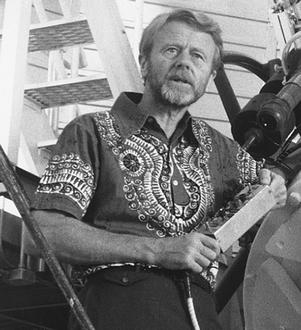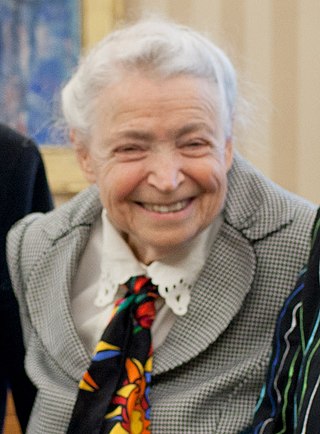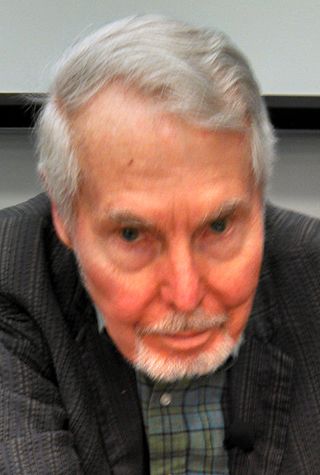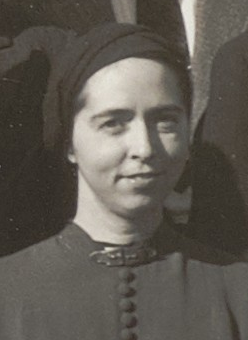Related Research Articles
Neutronium is a hypothetical substance composed purely of neutrons. The word was coined by scientist Andreas von Antropoff in 1926 for the hypothetical "element of atomic number zero" that he placed at the head of the periodic table. However, the meaning of the term has changed over time, and from the last half of the 20th century onward it has been also used to refer to extremely dense substances resembling the neutron-degenerate matter theorized to exist in the cores of neutron stars; hereinafter "degenerate neutronium" will refer to this.
A tetraneutron is a hypothetical stable cluster of four neutrons. The existence of this cluster of particles is not supported by current models of nuclear forces. There is some empirical evidence suggesting that this particle does exist, based on a 2001 experiment by Francisco-Miguel Marqués and co-workers at the Ganil accelerator in Caen using a novel detection method in observations of the disintegration of beryllium and lithium nuclei. However, subsequent attempts to replicate this observation have failed.

Harlow Shapley was an American scientist, head of the Harvard College Observatory (1921–1952), and political activist during the latter New Deal and Fair Deal.

Anton M.J. "Tom" Gehrels was a Dutch–American astronomer, Professor of Planetary Sciences, and Astronomer at the University of Arizona, Tucson.

Henrietta Hill Swope was an American astronomer who studied variable stars. In particular, she measured the period-luminosity relation for Cepheid stars, which are bright variable stars whose periods of variability relate directly to their intrinsic luminosities. Their measured periods can therefore be related to their distances and used to measure the size of the Milky Way and distances to other galaxies.

Mildred Dresselhaus, known as the "Queen of Carbon Science", was an American nanotechnologist. She was an Institute Professor and Professor Emerita of physics and electrical engineering at the Massachusetts Institute of Technology. Dresselhaus won numerous awards including the Presidential Medal of Freedom, the National Medal of Science, the Enrico Fermi Award and the Vannevar Bush Award.

Cluster decay, also named heavy particle radioactivity, heavy ion radioactivity or heavy cluster decay, is a rare type of nuclear decay in which an atomic nucleus emits a small "cluster" of neutrons and protons, more than in an alpha particle, but less than a typical binary fission fragment. Ternary fission into three fragments also produces products in the cluster size. The loss of protons from the parent nucleus changes it to the nucleus of a different element, the daughter, with a mass number Ad = A − Ae and atomic number Zd = Z − Ze, where Ae = Ne + Ze. For example:
Moscovium (115Mc) is a synthetic element, and thus a standard atomic weight cannot be given. Like all synthetic elements, it has no known stable isotopes. The first isotope to be synthesized was 288Mc in 2004. There are five known radioisotopes from 286Mc to 290Mc. The longest-lived isotope is 290Mc with a half-life of 0.65 seconds.

John David Jackson was a Canadian–American physics professor at the University of California, Berkeley and a faculty senior scientist emeritus at Lawrence Berkeley National Laboratory.
Kurt Gottfried was an Austrian-born American physicist who was professor emeritus of physics at Cornell University. He was known for his work in the areas of quantum mechanics and particle physics and was also a co-founder with Henry Way Kendall of the Union of Concerned Scientists. He wrote extensively in the areas of physics and arms control.

Superfluidity is the characteristic property of a fluid with zero viscosity which therefore flows without any loss of kinetic energy. When stirred, a superfluid forms vortices that continue to rotate indefinitely. Superfluidity occurs in two isotopes of helium when they are liquefied by cooling to cryogenic temperatures. It is also a property of various other exotic states of matter theorized to exist in astrophysics, high-energy physics, and theories of quantum gravity. The theory of superfluidity was developed by Soviet theoretical physicists Lev Landau and Isaak Khalatnikov.
Phyllis S. Freier was an American astrophysicist and a Fellow, American Association for the Advancement of Science and a Fellow, American Physical Society. Freier also served on NASA committees. As a graduate student she presented evidence for the existence of elements heavier than helium in cosmic radiation. Her work was published in Physical Review in 1948 with co-authors Edward J. Lofgren, Edward P. Ney, and Frank Oppenheimer.
Lawrence Christian Biedenharn, Jr. was an American theoretical nuclear physicist and mathematical physicist, a leading expert on applications of Lie group theory to physics.
Mildred Shapley Matthews was a book editor and writer known for astronomy books. She was the daughter of astronomers Harlow Shapley and Martha Betz Shapley; her father named the asteroid 878 Mildred for her.

In nuclear physics, ab initio methods seek to describe the atomic nucleus from the bottom up by solving the non-relativistic Schrödinger equation for all constituent nucleons and the forces between them. This is done either exactly for very light nuclei or by employing certain well-controlled approximations for heavier nuclei. Ab initio methods constitute a more fundamental approach compared to e.g. the nuclear shell model. Recent progress has enabled ab initio treatment of heavier nuclei such as nickel.
Ramona Lynn Vogt is a high-energy physicist at Lawrence Livermore National Laboratory.

Carol Jane Anger Rieke was an American astronomer, computational chemist, and mathematics educator. She co-authored papers with Nobel Prize laureate Robert S. Mulliken.
Martha Betz Shapley (1890–1981) was an American astronomer known for her research on eclipsing binary stars.
Olga Evdokimov is a Russian born professor of physics at the University of Illinois, Chicago (UIC). She is a High Energy Nuclear Physicist, who currently collaborates on two international experiments; the Solenoidal Tracker At RHIC (STAR) experiment at the Relativistic Heavy Ion Collider (RHIC), Brookhaven National Laboratory, Upton, New York and the Compact Muon Solenoid (CMS) experiment at the LHC, CERN, Geneva, Switzerland.
Tanya Zelevinsky is a professor of physics at Columbia University. Her research focuses on high-precision spectroscopy of cold molecules for fundamental physics measurements, including molecular lattice clocks, ultracold molecule photodissociation, as well as cooling and quantum state manipulation techniques for diatomic molecules with the goal of testing the Standard Model of particle physics. Zelevinsky graduated from MIT in 1999 and received her Ph.D. from Harvard University in 2004 with Gerald Gabrielse as her thesis advisor. Subsequently, she worked as a post-doctoral research associate at the Joint Institute for Laboratory Astrophysics (JILA) with Jun Ye on atomic lattice clocks. She joined Columbia University as an associate professor of physics in 2008. Professor Zelevinsky became a Fellow of the American Physical Society in 2018 and received the Francis M. Pipkin Award in 2019.
References
- 1 2 Matthews, Mildred Shapley (2021). June Matthews, Thomas Bogdan (ed.). Shapley's round table : A memoir by the astronomer's daughter. ISBN 978-1098383565.
- ↑ Mathews, June Lorraine (January 1, 1967). "High Energy Nuclear Photoeffect Light Elements". Bibcode:1967PhDT........22M – via NASA ADS.
- ↑ "June Matthews PhD '67 » MIT Physics".
- ↑ "Matthews to support 'highest quality research' as head of LNS". MIT News | Massachusetts Institute of Technology.
- ↑ Jay M. Pasachoff (January 25, 2022). "Shapley's Round Table: A Memoir by the Astronomer's Daughter". The Key Reporter.